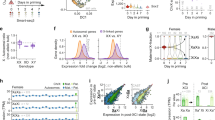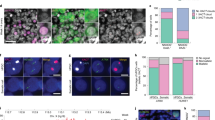Abstract
In mammals, dosage compensation ensures equal X-chromosome expression between males (XY) and females (XX) by transcriptionally silencing one X chromosome in XX embryos1. In the prevailing view, the XX zygote inherits two active X chromosomes, one each from the mother and father, and X inactivation does not occur until after implantation2,3,4,5,6. Here, we report evidence to the contrary in mice. We find that one X chromosome is already silent at zygotic gene activation (2-cell stage). This X chromosome is paternal in origin and exhibits a gradient of silencing. Genes close to the X-inactivation centre show the greatest degree of inactivation, whereas more distal genes show variable inactivation and can partially escape silencing. After implantation, imprinted silencing in extraembryonic tissues becomes globalized and more complete on a gene-by-gene basis. These results argue that the XX embryo is in fact dosage compensated at conception along much of the X chromosome. We propose that imprinted X inactivation results from inheritance of a pre-inactivated X chromosome from the paternal germ line.
This is a preview of subscription content, access via your institution
Access options
Subscribe to this journal
Receive 51 print issues and online access
$199.00 per year
only $3.90 per issue
Buy this article
- Purchase on Springer Link
- Instant access to full article PDF
Prices may be subject to local taxes which are calculated during checkout




Similar content being viewed by others
References
Lyon, M. F. Gene action in the X-chromosome of the mouse (Mus musculus L.). Nature 190, 372–373 (1961)
Mukherjee, A. B. Cell cycle analysis and X-chromosome inactivation in the developing mouse. Proc. Natl Acad. Sci. USA 73, 1608–1611 (1976)
Epstein, C., Smith, S., Travis, B. & Tucker, G. Both X-chromosomes function before visible X-chromosome inactivation in female mouse embryos. Nature 274, 500–503 (1978)
Kratzer, P. G. & Gartler, S. M. HGPRT activity changes in preimplantation mouse embryos. Nature 274, 503–504 (1978)
Adler, D. A., West, J. D. & Chapman, V. M. Expression of alpha-galactosidase in preimplantation mouse embryos. Nature 267, 838–839 (1977)
Lyon, M. F. in Results and Problems in Cell Differentiation (ed. Ohlsson, R.) 73–90 (Springer, Heidelberg, 1999)
Takagi, N. & Sasaki, M. Preferential inactivation of the paternally derived X-chromosome in the extraembryonic membranes of the mouse. Nature 256, 640–642 (1975)
Marahrens, Y., Panning, B., Dausman, J., Strauss, W. & Jaenisch, R. Xist-deficient mice are defective in dosage compensation but not spermatogenesis. Genes Dev. 11, 156–166 (1997)
Kay, G. F. et al. Expression of Xist during mouse development suggests a role in the initiation of X chromosome inactivation. Cell 72, 171–182 (1993)
Matsui, J., Goto, Y. & Takagi, N. Control of Xist expression for imprinted and random X chromosome inactivation in mice. Hum. Mol. Genet. 10, 1393–1401 (2001)
Huynh, K. D. & Lee, J. T. Imprinted X inactivation in eutherians: a model of gametic execution and zygotic relaxation. Curr. Opin. Cell Biol. 13, 690–697 (2001)
Krietsch, W. K. et al. The expression of X-linked phosphoglycerate kinase in the early mouse embryo. Differentiation 23, 141–144 (1982)
Latham, K. E., Patel, B., Bautista, F. D. M. & Hawes, S. M. Effects of X chromosome number and parental origin on X-linked gene expression in preimplantation mouse embryos. Biol. Reprod. 63, 64–73 (2000)
Mayer, W., Niveleau, A., Walter, J., Fundele, R. & Haaf, T. Demethylation of the zygotic paternal genome. Nature 3, 501–502 (2000)
Hall, L. L. et al. An ectopic human XIST gene can induce chromosome inactivation in postdifferentiation human HT-1080 cells. Proc. Natl Acad. Sci. USA 99, 8677–8682 (2002)
Schultz, R. M. Regulation of zygotic gene activation in the mouse. Bioessays 15, 531–538 (1993)
Hartshorn, C., Rice, J. E. & Wangh, L. J. Differential pattern of Xist RNA accumulation in single blastomeres isolated from 8-cell stage mouse embryos following laser zona drilling. Mol. Reprod. Dev. 64, 41–51 (2003)
Mak, W. et al. Mitotically stable association of polycomb group proteins Eed and Enx1 with the inactive X chromosome in trophoblast stem cells. Curr. Biol. 12, 1016–1020 (2002)
Nothias, J. Y., Majumder, S., Kaneko, K. J. & DePamphilis, M. L. Regulation of gene expression at the beginning of mammalian development. J. Biol. Chem. 270, 22077–22080 (1995)
Heard, E., Clerc, P. & Avner, P. X-chromosome inactivation in mammals. Annu. Rev. Genet. 31, 571–610 (1997)
Wutz, A. & Jaenisch, R. A shift from reversible to irreversible X inactivation is triggered during ES cell differentiation. Mol. Cell 5, 695–705 (2000)
Chadwick, B. P. & Willard, H. F. SETting the stage: Eed-Enx1 leaves and epigenetic signature on the inactive X chromosome. Dev. Cell 4, 445–447 (2003)
Duthie, S. M. et al. Xist RNA exhibits a banded localization on the inactive X chromosome and is excluded from autosomal material in cis. Hum. Mol. Genet. 8, 195–204 (1999)
Lifschytz, E. & Lindsley, D. L. The role of X-chromosome inactivation during spermatogenesis. Proc. Natl Acad. Sci. USA 69, 182–186 (1972)
Graves, J. A. M. Mammals that break the rules: Genetics of marsupials and monotremes. Annu. Rev. Genet. 30, 233–260 (1996)
Lee, J. T. Molecular links between X-inactivation and autosomal imprinting: X-inactivation as a driving force for the evolution of imprinting. Curr. Biol. 13, R242–R254 (2003)
Jegalian, K. & Page, D. C. A proposed path by which genes common to mammalian X and Y chromosomes evolve to become X inactivated. Nature 394, 776–780 (1998)
Tanaka, S., Kunath, T., Hadjantonakis, A. K., Nagy, A. & Rossant, J. Promotion of trophoblast stem cell proliferation by FGF4. Science 282, 2072–2075 (1998)
Stavropoulos, N., Lu, N. & Lee, J. T. A functional role for Tsix transcription in blocking Xist RNA accumulation but not in X-chromosome choice. Proc. Natl Acad. Sci. USA 98, 10232–10237 (2001)
Carrel, L. et al. X inactivation analysis and DNA methylation studies of the ubiquitin activating enzyme E1 and PCTAIRE-1 genes in human and mouse. Hum. Mol. Genet. 5, 391–401 (1996)
Acknowledgements
We are grateful to S. Shinwa for instruction in manipulating pre-implantation embryos, and to S. Shibata and Y. Ogawa for sharing reagents. We thank C. L. Tsai, L. F. Zhang and B. K. Sun for critical reading of the manuscript, and all members of the laboratory for discussion. This work was funded by the National Institutes of Health, USA, the Pew Scholar Program, and the Howard Hughes Medical Institute.
Author information
Authors and Affiliations
Corresponding author
Ethics declarations
Competing interests
The authors declare that they have no competing financial interests.
Rights and permissions
About this article
Cite this article
Huynh, K., Lee, J. Inheritance of a pre-inactivated paternal X chromosome in early mouse embryos. Nature 426, 857–862 (2003). https://doi.org/10.1038/nature02222
Received:
Accepted:
Published:
Issue Date:
DOI: https://doi.org/10.1038/nature02222
This article is cited by
-
Gene regulation in time and space during X-chromosome inactivation
Nature Reviews Molecular Cell Biology (2022)
-
Meiotic sex chromosome inactivation and the XY body: a phase separation hypothesis
Cellular and Molecular Life Sciences (2022)
-
Maternal H3K27me3-dependent autosomal and X chromosome imprinting
Nature Reviews Genetics (2020)
-
A novel approach to differentiate rat embryonic stem cells in vitro reveals a role for RNF12 in activation of X chromosome inactivation
Scientific Reports (2019)
-
Perturbed maintenance of transcriptional repression on the inactive X-chromosome in the mouse brain after Xist deletion
Epigenetics & Chromatin (2018)
Comments
By submitting a comment you agree to abide by our Terms and Community Guidelines. If you find something abusive or that does not comply with our terms or guidelines please flag it as inappropriate.



